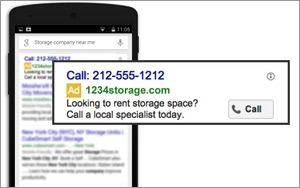 Google's call-only campaigns continue to spark buzz among advertisers. Some think consumers will be more inclined to call, rather than click -- especially from a smartphone -- draining
the budget more quickly. The ads serve the business phone number, business description and call button as people search. The tendency is to click on the number first.
Google's call-only campaigns continue to spark buzz among advertisers. Some think consumers will be more inclined to call, rather than click -- especially from a smartphone -- draining
the budget more quickly. The ads serve the business phone number, business description and call button as people search. The tendency is to click on the number first.
Some 70% of mobile
searchers call a business directly from search results, per a Google/Ipsos study.
The goal of the call-only search advertising campaigns is focused on getting more consumers to click to call
the business directly from mobile ads -- but does that require more people-power in the store to answer questions and take requests? The campaign feature lets advertisers use CPC bidding based on the
value of a call to the business. The feature also allows businesses to add existing phone information to new ads.
advertisement
advertisement
Since the feature only allow clicks to call, advertisers bid for calls to the
business rather than clicks to the Web site. This means the cost per click bid should match the value placed on a phone call from your advertisement. The default bid strategy maximizes calls.
Setting-up conversion tracking for calls means advertisers can use maximize conversions or Target CPA bidding.
Bob Sturges, account director at 3Q Digital for AdWords,
said click-to-call mobile ads are not new to AdWords, but the process of setting them up was previously done through a call extension. It's a different way to build out AdWords click-to-call ads in
the AdWords.
"It wasn't immediately obvious how to implement in the UI, and there were few articles out there detailing the process," Sturges said. "This shows Google's willingness to
embrace a mobile ad that completely eliminates the Web site, reinforcing its focus on helping advertisers find ways to make mobile sense."
Advertisers will need to track metrics off
these ads carefully, per Sturges. Many consumers probably don't realize that a click places a phone call even after the advertiser gets charged.
Sturges believes the ad type's only option to
call might get significantly fewer calls when comparing this ad type to a traditional search ad. "People who do call are usually a little more serious and can still provide good value for the brand or
retailer," he said. "If a client's Web site is not a great user experience on mobile, then cutting out a large volume of visitors in exchange for a smaller volume of calls can be a great
strategic move."